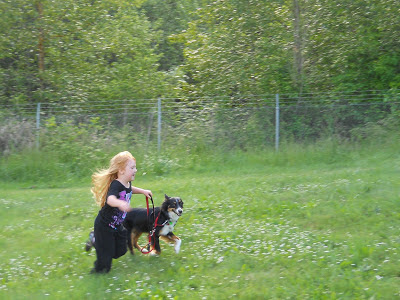Well if you are lucky and you have a puppy, stop now and don't follow where your pup is pulling. What ends up needing to happen is you need to put your dog through what is called an extinction curve. What's that you say? An extinction curve is where you do something expecting one thing to happen and something different happens. Say you go to open a door, you push and pull, but the door will not open. How quickly do you get frustrated? Pretty quick I'll bet. This is called experiencing an extinction curve. Now if from then on out door will no long open for you ever you will soon stop trying to open them as you have learned that door simply do not open for you even if you see others opening and closing them. The frustration lasts only as long as you keep trying and you feel better as soon as you stop.
So remember your dog is going to try harder, just like you would at opening a door, to get you to respond to the pulling like your normally have. Remember this also though, he will stop when he learns that it never gets him what he wants anymore. If the only way your dog learns that he can move forward is to be next to your side then that is what he will soon be doing. This is going to be much harder on you than it is on your dog however. I can say this with extreme confidence because most people either give up, which is what your dog is hoping and trying for, or you will turn to extreme measures like shock or prong collars.
If you need a crutch help while you and your dog go through this battle of wills so to speak, the best kind of help I can suggest is a "stop pull harness." No this is not your run of the mill harness, those will sometimes even encourage some dogs to pull harder. No, this is a harness that puts pressure on pressure points and makes pulling uncomfortable. It is just fine if the dog is walking next to you, but as soon as he starts pulling it make them uncomfortable, so the back off slightly and they get immediate relief. This is called a negative reinforcer. The dog does not get what it wants and gets negative feedback until it does do it correctly. This also is what you are doing when you stop walking as your dog pulls and wait for it to walk with you.
Here I have made my own "stop pulling leash" with my regular flat leash.
It goes over the head, between the front legs, the back up through the leash loop you made by going over the head.
Now I also recommend using positive reinforcement along with the negative here to help the dog learn a bit faster. If your dog gets rewarded with some goodies as it walks with you it helps the dog feel more inclined to do so. Lets say pushing and pulling did you no good when you tried to open doors, but you found that if you stuck out your tongue for 2 minutes that not only did the door open, but you also got a piece of chocolate, how much faster do you think you would learn what to do?
Part of the problem you will have is that to the dog, there are pieces of "chocolate" (interesting smells) all over the place *(note, please don't feed your dog chocolate). You need to make sure you are the most interesting thing out there to your dog, and for that you have your work cut out. It works best if you can let your dog know that he will get to check out those neat smells, if he walks next to you and doesn't pull because as soon as he pulls you stop. I know this makes taking your dog on a walk a bit of a pain, but the sooner you start the sooner your arm will ache less as the pulling lessens.
Everyone has a good time when all parties are happy!


No comments:
Post a Comment